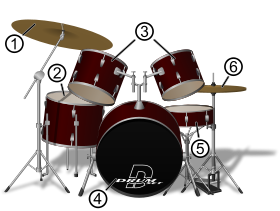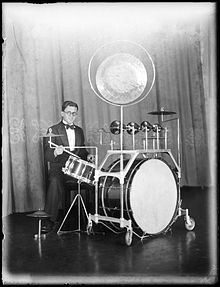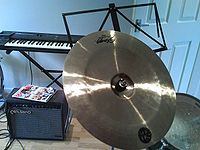- Drum kit
-
The drum kit 1 Ride cymbal | 2 Floor tom | 3 Toms
4 Bass drum | 5 Snare drum | 6 Hi-hat
Other components Crash cymbal | China cymbal | Splash cymbal | Sizzle cymbal
Swish cymbal | Cowbell | Wood block | Tambourine
Rototom | Octoban | HardwareA drum kit (also drum set,[1] or trap set) is a collection of drums, cymbals and often other percussion instruments, such as cowbells, wood blocks, triangles, chimes, or tambourines, arranged for convenient playing by a single person (drummer).
The individual instruments of a drum kit are hit by a variety of implements held in the hand, including sticks, brushes, and mallets. Two exceptions include the bass drum, played by a foot-operated pedal, and the hi-hat cymbals, which may be struck together using a foot pedal in addition to being played with sticks or brushes. Although other instruments can be played using a pedal, the feet are usually occupied by the bass drum and hi hat, and as a result the drummer often plays in a seated position. Percussion notation is often used by drummers to signify which drum kit components are to be played. A full size drum kit without any additional percussion instruments includes a bass drum, floor tom, snare drum, tom-toms, and a variety of cymbals including hi-hat cymbals, a ride cymbal and one or more crash cymbals. The exact set-up is dictated by the type of music played and the drummer's personal preferences. For example, in most forms of rock music, the bass drum, hi-hat and snare drum are the primary instruments used to create a drum beat, whereas in jazz, ride and snare patterns tend to be more prevalent and the hi-hat is played with the foot.
Drum kits have ranged in size and components from old style jazz/dance hall kits through to modern rock/techno kits.
Contents
History and development
Drum kits are infants of the Vaudeville era. Pecuniary and theater space considerations demanded that fewer percussionists covered more percussion parts. In military and orchestral music settings, drums and cymbals were traditionally played separately by one or many percussionists. The bass drum, snare drum, cymbals and other percussion instruments were played by hand. Circa 1890, experimentation with foot pedals began. Liberating the hands for the first time, this evolution saw the bass drum played (first standing) with the foot of a percussionist and became the central piece around which every other percussion instruments would later revolve. Ludwig-Musser, William F. Ludwig Senior and his brother Theodor Ludwig founded the Ludwig & Ludwig Co. in 1909 and patented the first workable bass drum pedal system, paving the way for what was to become the modern drum kit
By World War I drum kits were characterized by very large bold marching bass drums and many percussion items suspended on and around them, and they became a central part of jazz music, specifically (but not limited to) dixieland. Metal consoles were developed to hold Chinese tom-toms, with swing out stands for snare drums and cymbals. On top of the console was a "contraption" (shortened to "trap") tray used to hold whistles, klaxons, and cowbells, thus drum kits were dubbed "trap kits." Hi-hat stands appeared around 1926.
By the 1930s, Ben Duncan and others popularized streamlined trap kits leading to a basic four piece drum set standard: bass, snare, tom-tom, and floor tom. In time legs were fitted to larger floor toms, and "consolettes" were devised to hold smaller tom-toms on the bass drum. In the 1940s, Louie Bellson pioneered use of two bass drums, or the double bass drum kit. Gene Krupa was the first drummer to head his own orchestra and thrust the drums into the spot light with his drum solos, and others would soon follow his lead. Krupa is also known to be the first to record a drum solo on a commercial record.
With the ascendance of rock and roll, a watershed moment occurred between 1962 and 1964 when the Surfaris released "Wipe Out," and when Ringo Starr of The Beatles played his Ludwig kit on American television; events that motivated legions to take up the drums.
The trend towards bigger drum kits in Rock music began in the 1960s and gained momentum in the 1970s. By the 1980s, widely popular drummers like Billy Cobham, Carl Palmer, Nicko McBrain, Phil Collins, Stewart Copeland and perhaps most notably Neil Peart were using large numbers of drums and cymbals[1] and had also begun using electronic drums. In the 1990s and 2000s, many drummers in popular music and indie music have reverted back to basic four piece drum set standard.[2]
In the 21st century, it is not uncommon for drummers to use a variety of auxiliary percussion instruments, found objects, and electronics as part of their "drum" kits. Popular electronics include: electronic sound modules; laptop computers used to activate loops, sequences and samples; metronomes and tempo meters; recording devices; and personal sound reinforcement equipment (e.g., a small PA system to amplify electronic drums and provide a monitor for singing).
Recording
On early recording mediums such as wax cylinders and discs carved with an engraving needle, it was noted that cymbals distorted sound and affected the spectrum of sound at playback. To remedy the situation, drummers were often asked to play the content of the cymbals onto woodblocks, temple blocks and cowbells because of their short attack.
This recording-specific particularity had the effect of altering the evolution of the drum set and of stigmatizing the sound of the music recorded at the time.
Components
The exact collection of a drum kit's components depends on factors such as musical style, personal preference, and transportation options of the drummer. Cymbal, hi-hat, and tom-tom stands, as well as bass drum pedals and drum thrones are usually standard in most drum kits. Most mass produced drum kits are sold in one of two five-piece configurations (referring to the number of drums only), which typically include a bass drum, a snare drum, two toms, and one floor tom.
Drum pedals have a felt, plastic, or wooden beater which the drummer operates by pressing down on the pedal. When the pedal is depressed, it pulls a chain, metal shaft, or sturdy cloth or plastic strap which is attached to the end of the fulcrum-mounted beater rod. Some bass pedals are designed to be attached to the bass drum using metal screws. The double bass pedal was developed to eliminate the need for a second bass drum. It has since become popular in metal music. Drummers that use two bass drums or pedals usually have their hi-hat unscrewed or have a different cymbal in place of the hi-hat, because of the extra kick pedal. Some drummers make use of a drop clutch, which is used to open or close the hi hat by tapping a device with the stick as an alternative to using the foot pedal. When the drop clutch is closed, this keeps the hi-hats closed without the drummer having to hold down the pedal. This frees up the foot that is normally used with the hi-hat to perform on the second bass drum pedal.
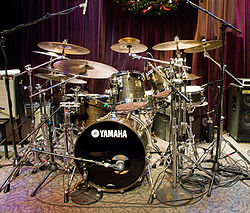 Drum kit, with microphones for playing live music.
Drum kit, with microphones for playing live music.
The standard hardware pack includes a hi-hat stand, a snare drum stand, two or three cymbal stands, and a bass drum pedal. Drum kits are usually offered as either complete kits which include drums and hardware, or as “shell packs” which include only the drums and sometimes tom mounting hardware. Cymbals are usually purchased separately and are also available in either packs or as individual pieces.
Basic drum kit
- Five-piece
- Bass drum & pedal(s)
- Snare drum
- Floor tom
- Mounted tom (with mounting hardware) or second floor tom
- Mounted tom (with mounting hardware)
- Hi-hat cymbals & stand
- Cymbal & stand
- Ride cymbal & stand
- Throne
"Four-piece kit", "five-piece kit", etc., refers to the actual number of drums in the set. Cymbals are not counted in this number.[2]
Accessories
Drummers who perform in concert venues often have a variety of equipment cases to transport the drums, cymbals and hardware. Performers who play local gigs may only have relatively inexpensive padded cloth bags or thin plastic cases. Professional touring drummers who have to ship their drums will typically have heavy-duty road cases that will securely hold and protect the equipment during transport. Professional drummers may also carry their own drum microphones with them to shows, to avoid situations where a venue has only substandard equipment. Dynamic microphones, which can handle high sound pressure levels are usually used to close-mic drums while condenser mics are used for overheads and room mics.[3] Some drummers who have their own mics have a set of drum-mounted mics, an approach which eliminates the need for mic stands and reduces set-up time. In some styles of music, drummers may also use electronic effects on drums. In some situations, drummers use noise gates that mute microphones below a threshold volume. This allows the sound engineer to use a higher overall volume for the drum kit, because it reduces the number of "active" mics which could feed back.
In some styles or settings, such as country music clubs or churches, the drummer may use a plexiglass screen to dampen the onstage volume of the drums. Many drummers who play in different venues carry carpeting or mats to prevent the bass drum from slipping on a wooden floor. Some drummers use an insulation-style filling or foam in the bass drum to lessen the "ringing" sound. Drummers often use a variety of accessories when they are practicing. Metronomes and beat counters are used to develop a steady rhythm. Drum muffling pads may be used to lessen the volume of drums during practicing.
Electronic drums
Main article: Electronic drums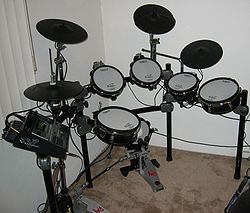 The Roland Roland V-Stage Series TD-12S V-Drum Kit is an electronic drum set. Shot also includes an extra PD-105 tom pad, CY-8 cymbal, Axis Longboard double kick pedal, and Iron Cobra Hi-Hat stand.
The Roland Roland V-Stage Series TD-12S V-Drum Kit is an electronic drum set. Shot also includes an extra PD-105 tom pad, CY-8 cymbal, Axis Longboard double kick pedal, and Iron Cobra Hi-Hat stand.
Some drummers use some or all electronic drum components. There are two approaches to using electronic drums. One approach is to use drum trigger pads for all of the different instruments. These pads are discs with a rubber-type coating that can be mounted on stands in the same locations that the traditional drum shells would be placed. Each disc has a piezoelectric transducer which transmits an electronic signal when it is struck. A patch cord from each drum pad disc is plugged into a drum synthesizer module and connected to the appropriate synthesized or sampled drum sound. Thus, when the drummer strikes the drum pad that is designated as the snare drum pad, the synthesizer module produces the sound of a snare drum. Since the sound is produced by a synthesizer, a performer can choose a range of sounds, such as samples of an actual drum or cymbal or electronic drum sounds. A drummer could even have the synthesizer produce non-drum sounds, such as sound effects or pitched notes.
The advantage of playing with a purely electronic drum kit is that there is no live drum sound, apart from any sound from a monitor or keyboard amplifier (which can be easily turned up or down). This may be desirable for venues in which only a quiet drum sound is desired, as in the case of a church or a music theater show. As well, a drummer with electronic drums can practice without being concerned about disturbing other people. Another advantage is that electronic drums do not need to be mic-ed and sound-checked. The disadvantage of electronic drums is that they may not have the full range of tonal options and textures that are available with acoustic drums. For example, an entry-level electronic drum system will have a snare sound, but the snare drum pad may not have a sensor that detects "rim shots". Also, the pads and plastic cymbals do not have the same feel as real drums and cymbals. Another disadvantage is that an electronic drum set needs to have a keyboard amplifier or PA system in order to be heard in a rehearsal.
Another approach to making electronic drums is to use an acoustic drum kit (wooden shells and metal cymbals) and attach trigger sensors to each drum or cymbal. The sensors are then routed to a synthesizer module in the same fashion as a purely electronic drum kit. The advantage of this approach is that a drummer could switch between traditional, natural drum sounds and electronica drum sounds throughout a performance.
Sizing
Snare, tom and bass drum sizes are commonly expressed as diameter x depth, both in inches. For example, 14 x 5.5 (a popular snare size) would mean that the drum is 14 inches wide and 5.5 inches deep. However, some manufacturers reverse the conventional notation and put the depth first; they would call the aforementioned size 5.5 x 14. Makers who use the conventional diameter-first method include Drum Workshop, Slingerland, Premier Percussion, Tama Drums, Pearl Drums, Pork Pie Percussion, Ludwig, Sonor, Mapex, and Yamaha Drums
The standard sizes for a 5 piece, "2 up, 1 down" rock kit are: 22" x 18" bass drum, 12" x 9" rack tom, 13" x 10" rack tom, 16" x 16" floor tom and a 14" x 5.5" snare drum. Another common sized drum kit is a fusion set. A standard 5 piece fusion drum kit will consist of a 20" x 16" bass drum, 10" x 8" rack tom, 12" x 9" rack tom, 14" x 14" floor tom and a 14" x 5.5" snare drum. Jazz drum kits usually exclude the mid tom. In recent years manufacturers have introduced a modification to the standard rock kit, with more and more drum makers offering a "1 up, 2 down" configuration, where there are two floor toms and only one rack tom. This setup was first pioneered by Led Zeppelin's John Bonham, who in fact modeled his kit after Gene Krupa, a Big Band era jazz drummer. The amount of pieces in a drum kit can vary widely from player to player due to personal preference. Setups range from minimal kits mainly used in rockabilly and dixieland jazz to enormous kits in some progressive rock, fusion, and metal groups.
The size of bass drums differs a great deal between different styles. A jazz drummer may use a relatively small bass drum, because in jazz, the bass drum is often used more as an accent instrument than for laying down a heavy beat. In contrast, a metal or hard rock drummer may have a very large bass drum (often multiple bass drums) that can produce a deep, punchy tone.
Audio samples
Audio samples Component Content Audio (Vorbis: click the arrow to play) Snare Unmuffled snare drum Muffled snare drum Rim click on a snare Bass drum Muffled bass drum Toms 8-inch (20 cm) rack tom 12-inch (30 cm) rack tom Floor tom Hi-hat Closed hi-hat Open hi-hat Hi-hat being opened and closed by its foot pedal (chick) Crash Crash cymbal Ride Hit on the bow Hit on the bell of the cymbal Hit on the edge Beat A typical rock beat on hi-hat Typical rock beat on ride cymbal Video sample Multiple components Video illustrating basic drum kit actions Video illustrating basic drum kit actions
See the Drums category at Wikipedia Commons for more See also
References
- ^ Peckman, Jonathan (2007). Picture Yourself Drumming, p.30. ISBN 1598633309.
- ^ a b Peckman (2007), p.31.
- ^ Drum Lessons - Drumbook.org
External links
Categories:- Drumming
- Drum kit components
- Percussion instruments
- Membranophones
- American musical instruments
- Drums
Wikimedia Foundation. 2010.

